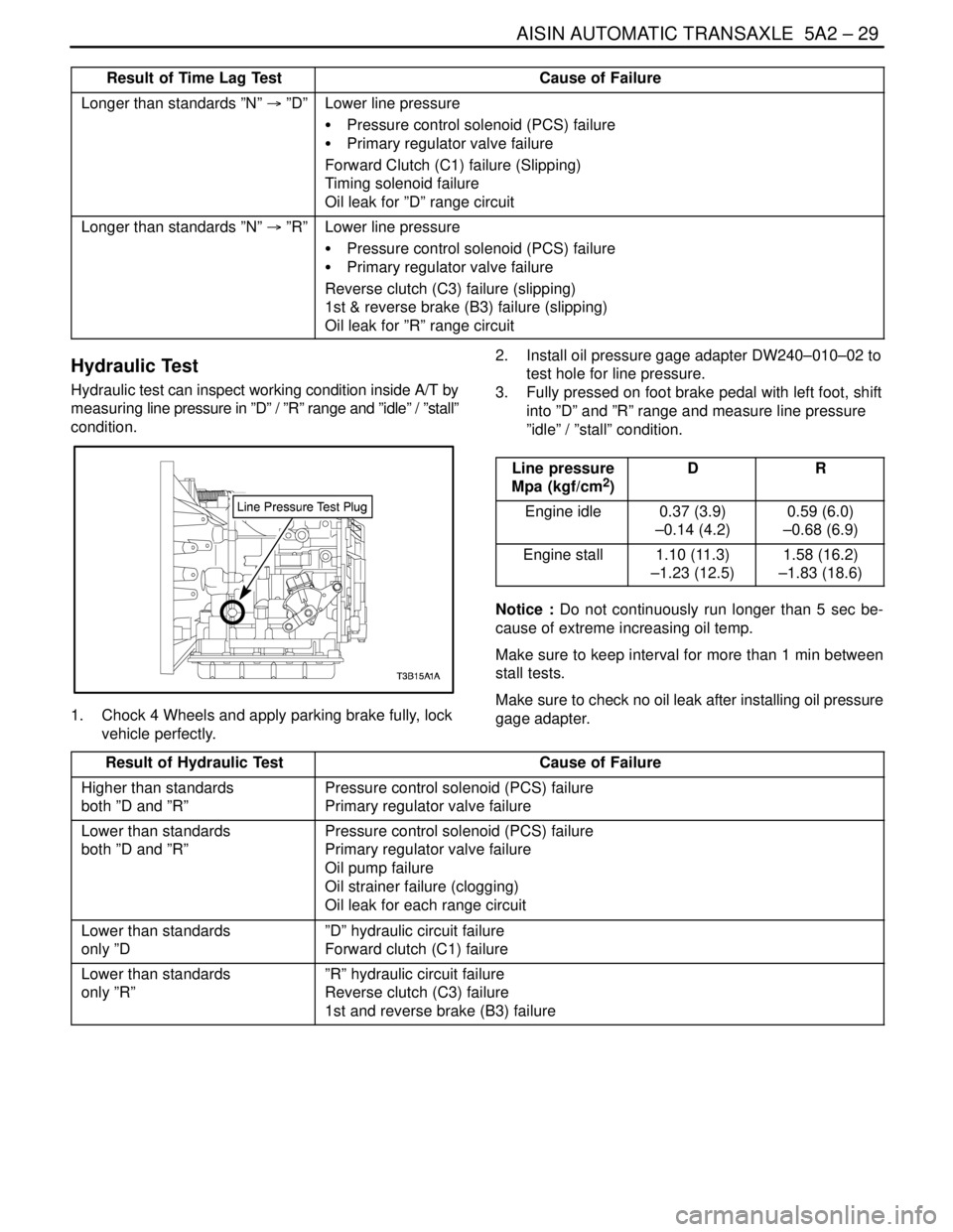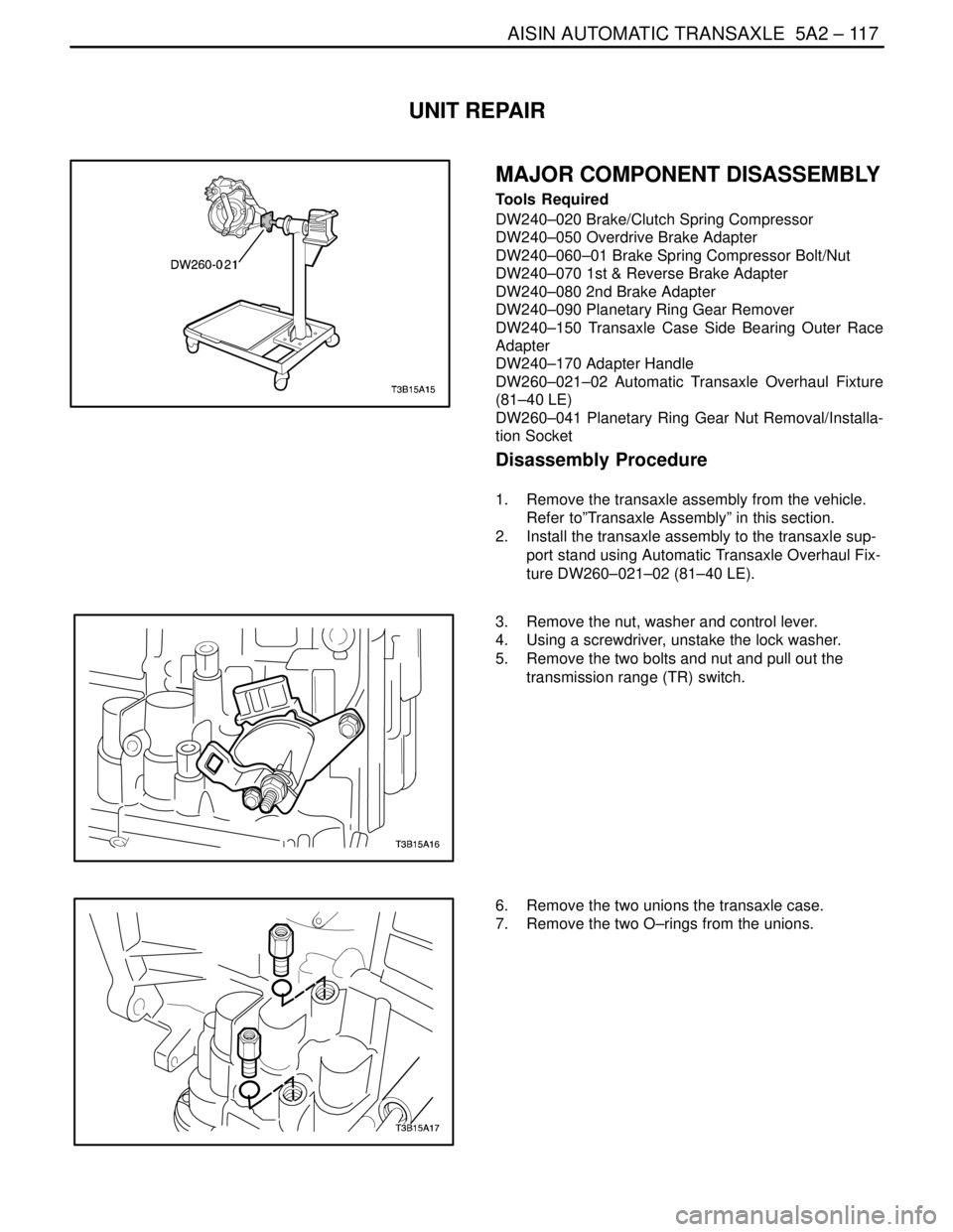Page 1617 of 2643

AISIN AUTOMATIC TRANSAXLE 5A2 – 27
DAEWOO V–121 BL4
WIRING HARNESS AND
CONNECTOR INSPECTION
1. Reproducing test
Perform symptom simulation test on the basis of
user’s condition. Refer to the below factors.
S Occuring–road condition, speed, accelerate,
reduce speed, straight, curve, air temperature,
weather, etc.
2. Inspect the connection condition of between con-
nectors.
Inspect the failure between connectors by visual
check and contact pressure check.
S Connector disconnected
S Terminals rusted
S Terminals deformation or loose fit
3. Inspect the Continuity of the wiring harness.
Disconnect both ends connector of wiring har-
ness, measure resistance between one connec-
tor terminal and other.
S Normal : 1Ω or less (No open circuit)
S Abnormal : � Ω (Open circuit)
Notice : Measure the resistance while slightly shaking
wire harness vertically and horizontally.
It is rare case wiring harness is broken at the middle of it,
and most cases occur at the connector.
4. Inspect the short circuit of the wiring harness.
Disconnect the connectors of the wiring harness
at both ends, measure resistance between the
applicable terminals of the connector and body
earth.
S Normal : 1M Ω or higher (No short circuit)
S Abnormal : Low resistance (Short circuit)Measure the resistance between one terminal
an another terminal in the same connector.(Ex-
cept between power supply or between earth).
S Normal : 1M Ω or higher (No short circuit)
S Abnormal : Low resistance (Short circuit)
Notice : Measure the wiring harness while slightly shaking
vertically and horzontally.
It is usual case of the short circuit that wiring harness is
crowded body and clamping failure.
5. Temporary connection failure of the connector.
It is thought that temporally the connection fail-
ure of the connector is cause when you can not
decide cause of DTC detection.
Therfore make sure to inspect and clean the
connector and delete the memorized DTC.
ROAD TEST
Road test is to diagnosis failure symptom accurately and
check the failure symptom after procedure.
Confirm whether below condition before road test. Oil tem-
perature is hot condition (50°C (122°F) ~ 80°C (176°F)).
1. D range test
S Check for up–shift, down–shift, kick–down and
lock–up operation at the shift point shown in the
shift schedule.
S Check for engine brake operation.
S Check for Check abnormal shock, noise and
harshness.
2. ”P” range test
Park vehicle on a gradient (more than 5°), shift
into the ”P” range and release parking brake.
Then, check to see no moving vehicle by opera-
tion of parking lock pawl.
Page 1618 of 2643

5A2 – 28IAISIN AUTOMATIC TRANSAXLE
DAEWOO V–121 BL4
FUNCTION CHECK
Confirm whether below condition before function check.
S Oil temperature is hot condition (50°C (122°F) ~
80°C (176°F)).
S Switch of A/C and light etc are off.
Stall Test
Stall test’ purpose is to inspect overall performance of A/T
and engine by measuring the stall speed in ”D” and ”R”
range.1. Chock 4 Wheels and apply parking brake fully, lock
vehicle perfectly.
2. Fully pressed on foot brake pedal with left foot.
3. Shift into ”D” and ”R” range, fully press on accelera-
tor pedal with right foot.
Quickly read stall speed at this time.
Standards
2390 ± 150 rpm
Notice : Do not continuously run longer than 5 sec be-
cause of extreme increasing oil temp.
Make sure to keep interval for more than 1 min between
stall tests.
Result of Stall Test
Cause of Failure
Lower than standards
both ”D” and ”R”Less engine power
Torque converter one way clutch failure
Higher than standards
only ”D”Lower line pressure
S Pressure control solenoid (PCS) failure
S Primary regulator valve failure
Forward clutch (C1) failure (Slipping)
No.2 One–way clutch (F2) failure
Higher than standards
only ”R”Lower line pressure
S Pressure control solenoid (PCS) failure
S Primary regulator valve failure
Reverse clutch (C3) failure (Slipping)
1st & reverse brake (B3) failure (Slipping)
Higher than standards
both ”D” and ”R”Lower line pressure
S Pressure control solenoid (PCS) failure
S Primary regulator valve failure
Oil pump failure
Oil strainer failure (clogging)
Oil leak for each range circuit
Time Lag Test
Time lag is time till slightly shock can be felt when shift le-
ver is shifted ”N” � ”D” and ”N” � ”R” while engine idling.
Time lag test can inspect hydraulic condition and clutch/
brake condition.
1. Chock 4 Wheels and apply parking brake fully, lock
vehicle perfectly.
2. Measure time lag by using stop watch from moment
when shift lever is shifted in ”N” � ”D” and ”N” �
”R” until moment slightly shock can be felt.”N � D”less than 0.7 sec
”N” � ”R”less than 1.2 sec
Notice : Make sure to take 3 measurement and take the
average value.
Make sure to keep interval for more than 1 min between
time lag tests. (That purpose is to remove clutch/brake
pressure was left unfinished.)
Page 1619 of 2643

AISIN AUTOMATIC TRANSAXLE 5A2 – 29
DAEWOO V–121 BL4
Result of Time Lag TestCause of Failure
Longer than standards ”N” � ”D”Lower line pressure
S Pressure control solenoid (PCS) failure
S Primary regulator valve failure
Forward Clutch (C1) failure (Slipping)
Timing solenoid failure
Oil leak for ”D” range circuit
Longer than standards ”N” � ”R”Lower line pressure
S Pressure control solenoid (PCS) failure
S Primary regulator valve failure
Reverse clutch (C3) failure (slipping)
1st & reverse brake (B3) failure (slipping)
Oil leak for ”R” range circuit
Hydraulic Test
Hydraulic test can inspect working condition inside A/T by
measuring line pressure in ”D” / ”R” range and ”idle” / ”stall”
condition.
1. Chock 4 Wheels and apply parking brake fully, lock
vehicle perfectly.2. Install oil pressure gage adapter DW240–010–02 to
test hole for line pressure.
3. Fully pressed on foot brake pedal with left foot, shift
into ”D” and ”R” range and measure line pressure
”idle” / ”stall” condition.
Line pressure
Mpa (kgf/cm
2)
DR
Engine idle0.37 (3.9)
–0.14 (4.2)0.59 (6.0)
–0.68 (6.9)
Engine stall1.10 (11.3)
–1.23 (12.5)1.58 (16.2)
–1.83 (18.6)
Notice : Do not continuously run longer than 5 sec be-
cause of extreme increasing oil temp.
Make sure to keep interval for more than 1 min between
stall tests.
Make sure to check no oil leak after installing oil pressure
gage adapter.
Result of Hydraulic Test
Cause of Failure
Higher than standards
both ”D and ”R”Pressure control solenoid (PCS) failure
Primary regulator valve failure
Lower than standards
both ”D and ”R”Pressure control solenoid (PCS) failure
Primary regulator valve failure
Oil pump failure
Oil strainer failure (clogging)
Oil leak for each range circuit
Lower than standards
only ”D”D” hydraulic circuit failure
Forward clutch (C1) failure
Lower than standards
only ”R””R” hydraulic circuit failure
Reverse clutch (C3) failure
1st and reverse brake (B3) failure
Page 1707 of 2643

AISIN AUTOMATIC TRANSAXLE 5A2 – 117
DAEWOO V–121 BL4
UNIT REPAIR
MAJOR COMPONENT DISASSEMBLY
Tools Required
DW240–020 Brake/Clutch Spring Compressor
DW240–050 Overdrive Brake Adapter
DW240–060–01 Brake Spring Compressor Bolt/Nut
DW240–070 1st & Reverse Brake Adapter
DW240–080 2nd Brake Adapter
DW240–090 Planetary Ring Gear Remover
DW240–150 Transaxle Case Side Bearing Outer Race
Adapter
DW240–170 Adapter Handle
DW260–021–02 Automatic Transaxle Overhaul Fixture
(81–40 LE)
DW260–041 Planetary Ring Gear Nut Removal/Installa-
tion Socket
Disassembly Procedure
1. Remove the transaxle assembly from the vehicle.
Refer to”Transaxle Assembly” in this section.
2. Install the transaxle assembly to the transaxle sup-
port stand using Automatic Transaxle Overhaul Fix-
ture DW260–021–02 (81–40 LE).
3. Remove the nut, washer and control lever.
4. Using a screwdriver, unstake the lock washer.
5. Remove the two bolts and nut and pull out the
transmission range (TR) switch.
6. Remove the two unions the transaxle case.
7. Remove the two O–rings from the unions.
Page 1710 of 2643
5A2 – 120IAISIN AUTOMATIC TRANSAXLE
DAEWOO V–121 BL4
22. Disconnect the manual valve control rod from the
manual valve lever, then remove the valve body
assembly.
23. Remove the check valve and spring.
24. Remove the brake drum gasket.
25. Remove the apply gasket.
Page 1712 of 2643
5A2 – 122IAISIN AUTOMATIC TRANSAXLE
DAEWOO V–121 BL4
WARNING : USE CAUTION WHEN REMOVING COM-
PONENTS WITH COMPRESSED AIR OR PERSONAL
INJURY MAY RESULT.
Notice : Blowing off the air may cause the piston’s jump–
out.When removing the piston, hold it with your hand using
a waste cloth.
Notice : Take care not to splash ATF when air–blowing.
32. Apply 392 kPa (57 psi) of compressed air to the oil
hole and remove the O/D & 2nd brake (B1) clutch
accumulator piston and spring.
33. Remove the 2 O–rings from the O/D & 2nd brake
(B1) accumulator piston.
34. Remove the bolt and the transaxle wire from the
transaxle case.
35. Remove the O–ring from the transaxle wire.
Page 1715 of 2643
AISIN AUTOMATIC TRANSAXLE 5A2 – 125
DAEWOO V–121 BL4
44. Remove the counter driven gear assembly from the
transaxle case.
45. Remove the 9 bolts and tap on the circumference
of the transaxle rear cover with a plastic hammer to
remove the transaxle rear cover from the transaxle
case.
46. Remove the 4 apply gaskets.
47. Remove 2nd coast & O/D brake (B1) flange, 2
discs and 2 plates from the transaxle case.
Page 1718 of 2643

5A2 – 128IAISIN AUTOMATIC TRANSAXLE
DAEWOO V–121 BL4
56. Remove the front planetary sun gear from the
transaxle case.
57. Remove the thrust bearing race from the front plan-
etary sun gear.
WARNING : USE CAUTION WHEN REMOVING SNAP
RINGS OR PERSONAL INJURY MAY RESULT.
Notice : Stop the press when the 2nd brake is lowered 1–
2 mm (0.039–0.078 in.) from the snap ring groove, pre-
venting the 2nd brake from being deformed.
58. Using brake spring compressor bolt/nut
DW240–060–01 and 2nd brake adapter
DW240–080, remove the 2 snap rings, 2nd brake
piston and 2nd brake piston return spring.
WARNING : USE CAUTION WHEN REMOVING COM-
PONENTS WITH COMPRESSED AIR OR PERSONAL
INJURY MAY RESULT.
Notice : Blowing off the air may cause the piston’s jump–
out.When removing the piston, hold it with your hand using
a waste cloth.
Notice : Take care not to splash ATF when air–blowing.
59. Apply 392 kPa (57 psi) of compressed air to the
2nd brake to remove the 2nd brake piston from the
2nd brake clutch cylinder.
60. Remove the 2 O–rings from the 2nd brake piston.